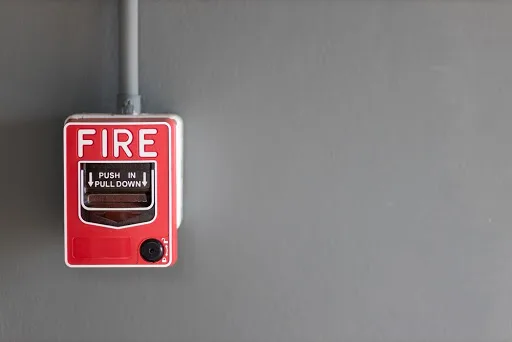When it comes to Fire & Life Safety, there are a lot of rules, and DynaFire follows them all. What can we say? We’re not rebels when it comes to protecting others. If you want to know a little more about fire extinguisher regulations in the workplace, you’re in the right place.
You’re going to spend approximately one-third of your life at work, and if you find that a little depressing, you must not love what you do as much as we do. Because you spend a large portion of your time at work, it’s important to keep your space safe and abide by fire extinguisher regulations in the workplace.
The Fire Triangle – Why Your Extinguisher Is So Important
There are three elements needed to create the chemical reaction necessary to start a fire, and if you want to sound like you know what you’re talking about, you could refer to those as the fire triangle. The three requirements are:
- Oxygen to sustain the combustion

- Heat to raise the temperature of the material to ignition levels
- Fuel to support combustion
If any one of these elements is missing, the fire can’t survive, and this is where your fire extinguisher comes into play. Different extinguishing methods remove or disrupt different elements on the fire triangle, which is why you may see a variety of fire extinguishers depending on the environment you work in.
OSHA And Fire Extinguisher Regulations In the Workplace
When it comes to workplace fire safety, we not only follow NFPA standards, but OSHA regulations as well. Here are the general requirements from OSHA 29 CFR 1910.157:
- Fire extinguishers need to be accessible to employees without subjecting them to possible injury
- Extinguishers in the workplace must be OSHA-approved
- Extinguishers must be fully operational and charged, and stored in a designated area when not in use
- Extinguishers using carbon tetrachloride or chlorobromomethane extinguishing agents are prohibited (there are additional extinguishers prohibited in the state of Florida, specifically those in statute 633.314 of the 2020 Florida Statutes)
- Extinguishers should be removed from the workplace that are soldered or riveted shell self-generating soda acid, or are self-generating foam or gas cartridge water type, and are operated by inverting the extinguisher to rupture a cartridge or generate a chemical reaction
If you’re feeling a little overwhelmed reading this, just be relieved that you can hire Fire & Life Safety experts like DynaFire. We learned all of this so you don’t have to…you’re welcome.
Do All Workplaces Need To Follow These Regulations?
As with many rules, there are exceptions to the OSHA fire extinguisher regulations in the workplace. A workplace with a written policy that requires all building occupants to evacuate when a fire alarm sounds, or that designates specific employees to use the extinguisher and all other occupants must evacuate, is exempt per OSHA 29 CFR 1910.38-39.
How Do I Know It’s Safe To Use A Fire Extinguisher?
If there’s a fire, there are three steps to take.
- Activate the fire alarm
- Assist anyone in immediate danger as long as it’s safe for you to do so
- Attempt only to extinguish the fire if it’s safe to do so, and after the previous two steps have been completed
If you want to read more on this topic, check out the sequel to our fire extinguisher regulations in the workplace series. And in the meantime, make sure to call us or fill out our online contact form. We can handle all your workplace fire extinguisher inspection, maintenance, and repair needs, and look good doing it.






